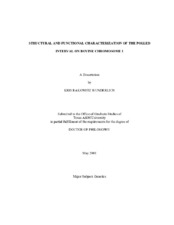| dc.description.abstract | The horned condition in cattle is believed to be the wild type with morphogenesis
primarily occurring after birth. The polled condition has existed since domestication and
has been selected for its economic importance. The polled locus has previously been
mapped by genetic linkage analysis to the proximal region of bovine chromosome 1. In
order to help us eventually identify the causative mutation, the objective of the study was
to structurally and functionally characterize the polled interval from IFNAR1 to SOD1
on BTA1. Our hypothesis was that the polled locus is a tissue specific transcription
factor that is expressed in the developing horn buds and acts directly or indirectly upon
SOX9.
A 2.5 Mb BAC contig and STS content map of the polled interval was
constructed. Three candidate genes encoding transcription factors were identified within
this region but only C21orf66 was expressed in the horn buds from 1 d old Bos indicus
influenced calves. The C21orf66 gene has 18 exons, spans 30,976 bp of genomic DNA,
and 144 SNP were identified. No single SNP discovered in C21orf66 can be attributed
as the causative mutation. None of the genes from the polled interval were differentially expressed in skin
and horn from 1 d old Bos indicus influenced calves. However, there were significant
differences in the levels of expression of RUNX2, SOX9, BMP4, PRKCA, and FOXL2 in
these samples. Expression of RUNX2 was localized to the osteoblasts, and both RUNX2
and SOX9 were expressed in sebaceous glands of the horn at 1 d of age. Histological
examination of horns and scurs from newborn, 5 to 6 mo, and ~1.5 yr old Bos indicus
influenced cattle suggest that horns form through intramembranous ossification.
Based on the data presented herein, we propose that the polled locus is upstream
of RUNX2 and SOX9 in the osteogenic pathway, and could have its primary effect on
the differentiation of mesenchymal condensations. The genes IL10RB, SFRS15,
C21orf66, OLIG1, OLIG2 and HUNK remain candidates for the polled locus and
warrant further investigation. | en |


